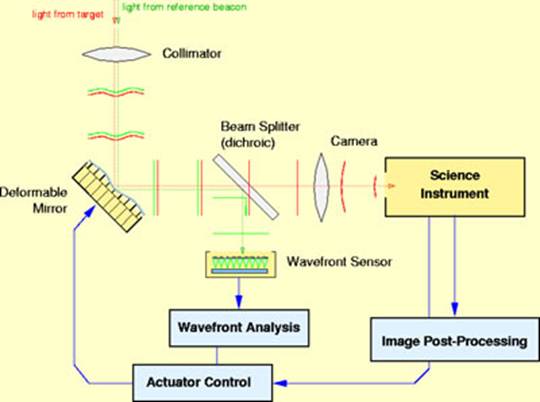





Published on Apr 02, 2024
Adaptive optics is a new technology which is being used now a days in ground based telescopes to remove atmospheric tremor and thus provide a clearer and brighter view of stars seen through ground based telescopes. Without using this system, the images obtained through telescopes on earth are seen to be blurred, which is caused by the turbulent mixing of air at different temperatures.
Adaptive optics in effect removes this atmospheric tremor. It brings together the latest in computers, material science, electronic detectors, and digital control in a system that warps and bends a mirror in a telescope to counteract, in real time the atmospheric distortion.
The advance promises to let ground based telescopes reach their fundamental limits of resolution and sensitivity, out performing space based telescopes and ushering in a new era in optical astronomy. Finally, with this technology, it will be possible to see gas-giant type planets in nearby solar systems in our Milky Way galaxy. Although about 100 such planets have been discovered in recent years, all were detected through indirect means, such as the gravitational effects on their parent stars, and none has actually been detected directly.
Adaptive optics refers to optical systems which adapt to compensate for optical effects introduced by the medium between the object and its image. In theory a telescope's resolving power is directly proportional to the diameter of its primary light gathering lens or mirror. But in practice , images from large telescopes are blurred to a resolution no better than would be seen through a 20 cm aperture with no atmospheric blurring. At scientifically important infrared wavelengths, atmospheric turbulence degrades resolution by at least a factor of 10.
Space telescopes avoid problems with the atmosphere, but they are enormously expensive and the limit on aperture size of telescopes is quite restrictive. The Hubble Space telescope, the world's largest telescope in orbit , has an aperture of only 2.4 metres, while terrestrial telescopes can have a diameter four times that size.
In order to avoid atmospheric aberration, one can turn to larger telescopes on the ground, which have been equipped with ADAPTIVE OPTICS system. With this setup, the image quality that can be recovered is close to that the telescope would deliver if it were in space. Images obtained from the adaptive optics system on the 6.5 m diameter telescope, called the MMT telescope illustrate the impact.

In the early 1970’s the U.S department of defense began supporting an effort to develop a real-time image correction system to obtain sharp pictures of Soviet satellites. The first high resolution images were obtained in 1982. over the next ten years, both military and astronomical communities vigorously advanced the state of the art . A new wavefront sensor and a new deformable mirror that were successfully tested. Later on, pioneering work by the U.S air force showed that an adaptive optics system could operate very efficiently using a laser to create an artificial star in the sky as the wave front reference. This information was a boost to the astronomers, and adaptive optics are now in regular use in large telescopes all over the world.
The European southern observatory, based in Germany operates a very large telescope. It consists of four separate 8-metre telescopes that can be optically linked to form one giant telescope. At present just one of them is fitted with adaptive optics system, feeding a near –infrared camera and low resolution spectrograph, but plans for the eventual addition of adaptive optics to all four.
One other telescope bears special mention: the three meter Shane telescope of the Lick Observatory, on Mt Hamilton. It’s the only telescope that doesn’t need to rely on light from a star to provide information on atmospheric distortion. Instead it uses a laser beam projected into the sky, tuned to 589 nm, the same wavelength as sodium vapour lamps. This laser beam excites a layer of sodium atoms 95 km above the earth’s surface left by meteorites.
These atoms scatter light back to the telescope, creating what looks like a glowing spot in the sky. Currently the lasers needed to do this job are expensive and difficult to maintain, but efforts are being made to change that. The W.M Keck Observatory will soon begin operation with a laser guide star, and as the laser becomes readily available, many other telescope projects will adopt the laser guide star approach to adaptive optics.
| Are you interested in this topic.Then mail to us immediately to get the full report.
email :- contactv2@gmail.com |